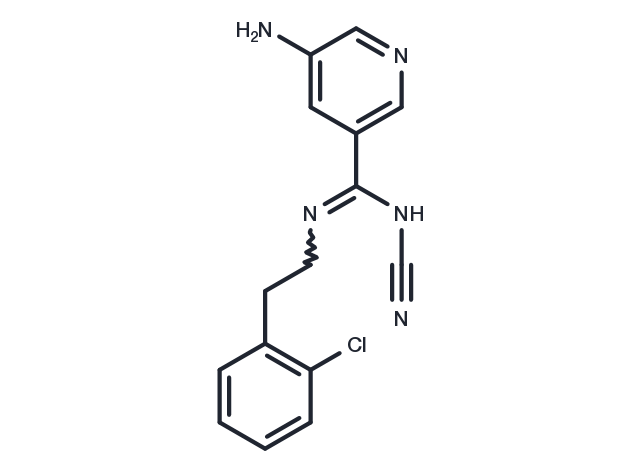Powder: -20°C for 3 years | In solvent: -80°C for 1 year


KRN 4884 is an opener of the K+ channel. KRN 4884 (0.1-3 μM) activates KATP channels in a concentration-dependent manner (EC50=0.55 μM), in the presence of intracellular ATP (1 mM).

| Pack Size | Availability | Price/USD | Quantity |
|---|---|---|---|
| 25 mg | 6-8 weeks | $ 1,520.00 | |
| 50 mg | 6-8 weeks | $ 1,980.00 | |
| 100 mg | 6-8 weeks | $ 2,500.00 |
| Description | KRN 4884 is an opener of the K+ channel. KRN 4884 (0.1-3 μM) activates KATP channels in a concentration-dependent manner (EC50=0.55 μM), in the presence of intracellular ATP (1 mM). |
| Targets&IC50 | KATP channel:(EC50)0.55 μM |
| In vitro | KRN4884 (1 and 3 μM) partially restores the KATP channel activity, after either the spontaneous or Ca2+-induced channel rundown. KRN4884 activates cardiac KATP channels through not only decreasing the sensitivity of the channel to ATP but also directly stimulating the opening of the channel. KRN4884 (0.3 and 3 μM) increases the outward current in a concentration-dependent manner, and the unitary current amplitudes are similar to that of KATP channels in the ATP-free solution. KRN4884 (0.3 μM) shifts the concentration-response relationship for ATP-induced KATP channel inhibition to the right and slightly upward direction without altering the slope. The effect of KRN4884 is augmented by the presence of uridine 5′-diphosphate (3 mM) [1]. |
| In vivo | KRN4884 treatment does not affect serum concentrations of total cholesterol and phospholipid, but increases free fatty acid levels. Rats receiving KRN4884 exhibite an increase in lipoprotein lipase (LPL) activity both in adipose tissue and in skeletal muscle. KRN4884 (3 mg/kg; p.o.; 10 days) treatment, leads to a significant reduction in serum triglyceride levels, which is comparable to that of Clofibrate (160 mg/kg). The effects of KRN4884, a novel pyridinecarboxamidine type KATP channel opener, on serum triglyceride levels are investigated in Sprague-Dawley rats. Reduction in serum triglyceride levels by KRN4884 and Clofibrate are accompanied by a reduction in triglyceride levels both in chylomicron and in very low density lipoprotein [2]. |
| Molecular Weight | 299.76 |
| Formula | C15H14ClN5 |
| CAS No. | 152802-84-1 |
Powder: -20°C for 3 years | In solvent: -80°C for 1 year
You can also refer to dose conversion for different animals. More
bottom
Please see Inhibitor Handling Instructions for more frequently ask questions. Topics include: how to prepare stock solutions, how to store products, and cautions on cell-based assays & animal experiments, etc.
KRN4884 152802-84-1 Others KRN 4884 KRN-4884 inhibitor inhibit
